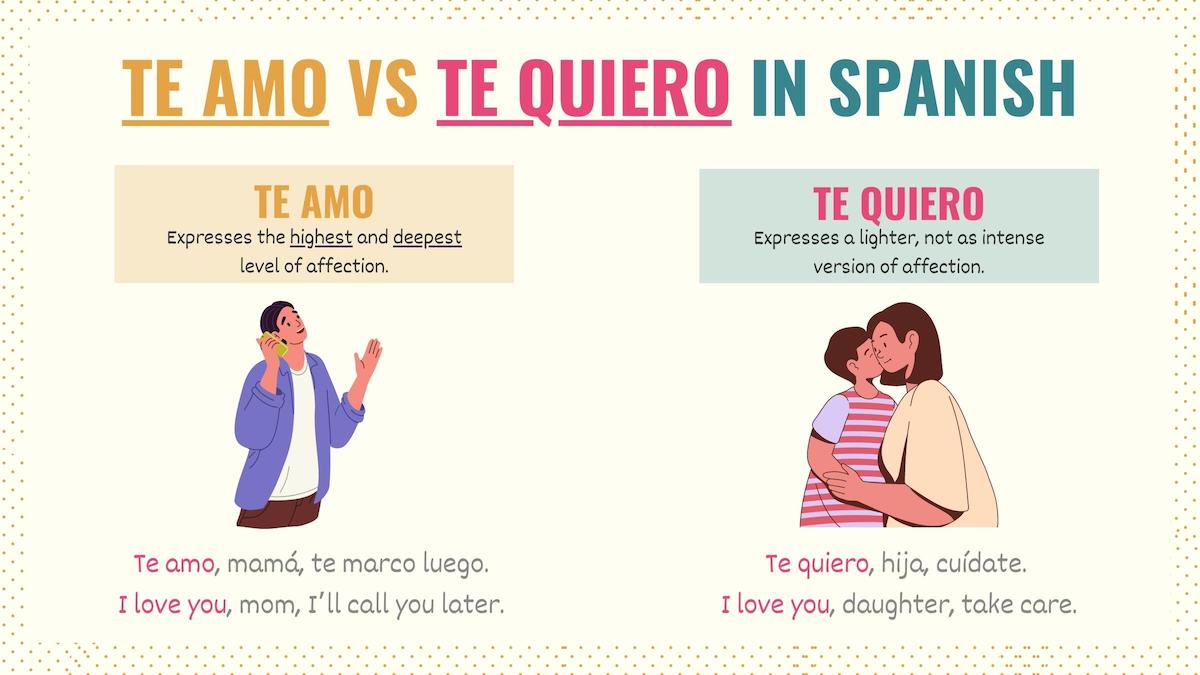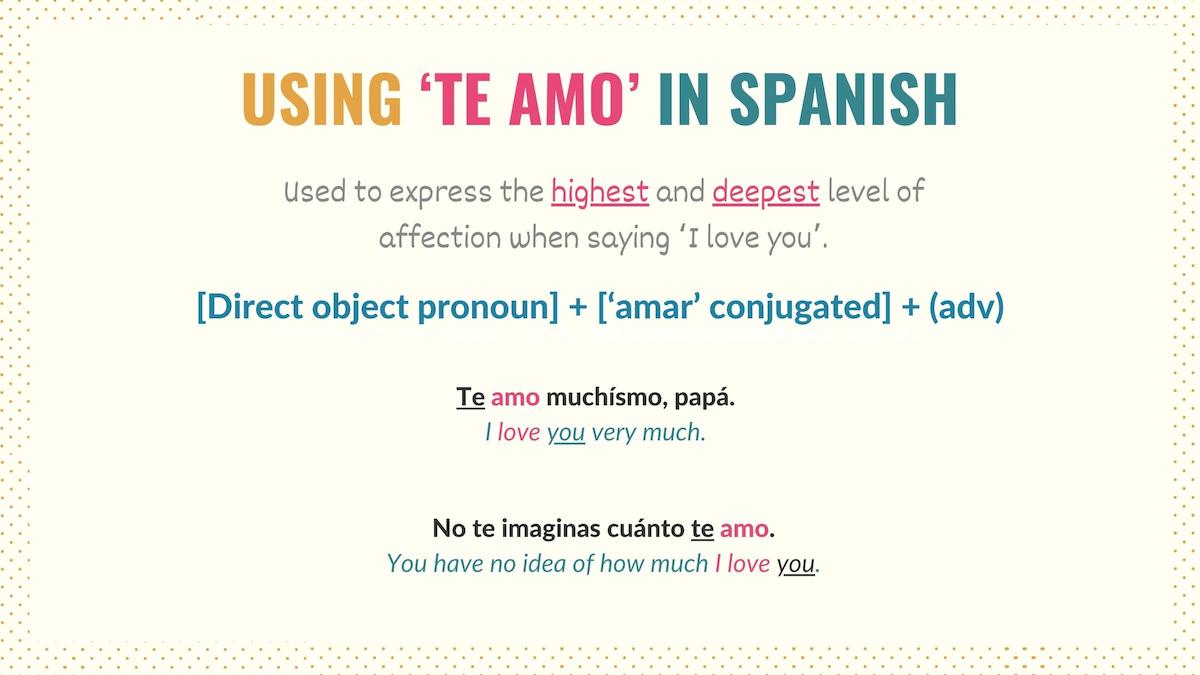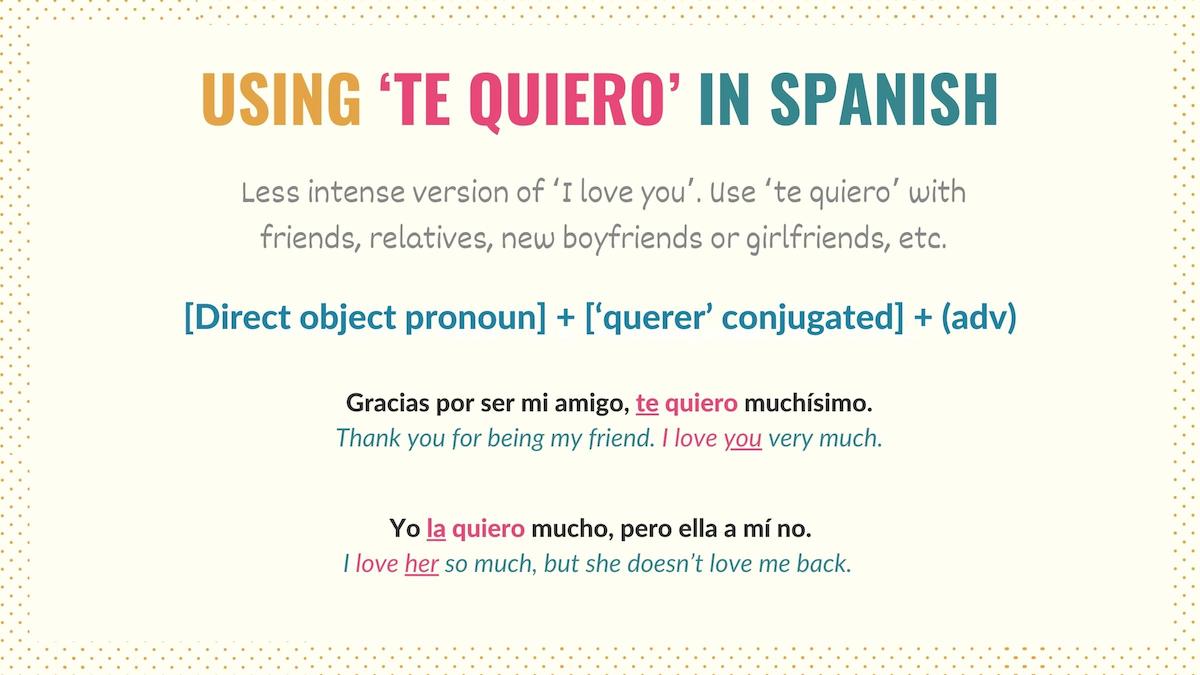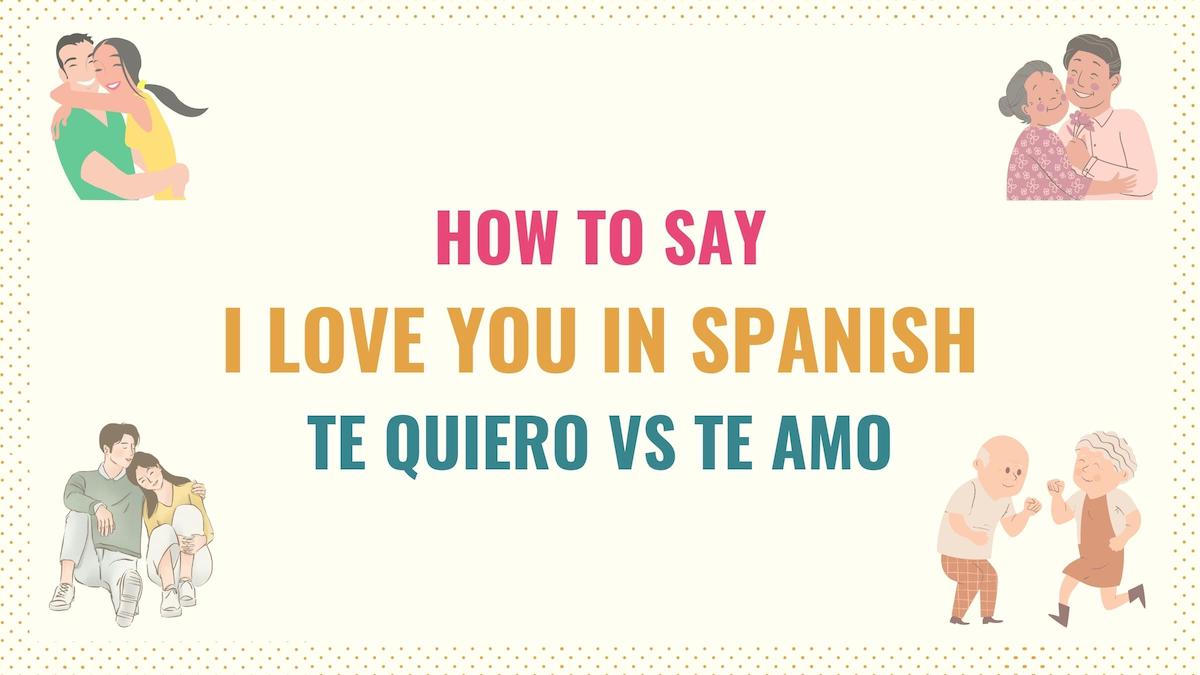Te quiero and te amo are the two standard ways to say ‘I love you’ in Spanish. Although they both express love, we don’t use these expressions interchangeably. Based on this, you may be wondering what’s the difference between ‘te quiero’ and ‘te amo’ in Spanish.
In Spanish, ‘te quiero’ and ‘te amo’ are used to express affection for someone. Te amo expresses a greater and deeper degree of affection. It is commonly used in romantic relationships. Te quiero is a less intense version of ‘te amo’. We use this expression with friends or new relationships.

Both ‘amar’ and ‘querer’ are translated as ‘to love’. However, these verbs have some nuances in meaning that you need to know. Since this difference may not be very clear, in this article, you’ll learn the difference between saying te amo or te quiero.
On top of providing you with examples, I’ll explain to you when and with whom you should use these expressions. Hopefully, by the end of this, you’ll have a better idea of how to say ‘I love you’ in Spanish.
What’s the Difference Between ‘Te amo’ and ‘Te quiero?
When referring to feelings or affections for someone, we Spanish speakers use te amo vs te quiero. Although, in this context, these phrases mean ‘I love you’, we use them in certain contexts and with certain people.
‘Te amo’ comes from the verb amar. It expresses the highest and deepest level of affection. Since it expresses profound feelings for someone, we typically use ‘te amo’ when we’re in love or want to express deep feelings for someone.
Te amo muchísimo, mi amor.
I love you very much, honey.
Te amo, mamá, te marco luego.
I love you, mom, I’ll call you later.
‘Te quiero’ also expresses affection, but it’s a light and not so intense version of ‘I love you’. As a result, you can use this expression to show affection to your friends, relatives or the person you’re dating.
Te quiero mucho, amiga.
I love you very much, my friend.
Te quiero, hija, cuídate.
I love you, daughter, take care.
In the following sections, we’ll discuss in-depth the different uses of these phrases and we’ll tell you with whom it’s more common to use one or the other.
How & When to Use ‘Te Amo’ in Spanish
As mentioned above, ‘te amo’ is the direct translation of ‘to love’. In Spanish, we only say this word when our feelings for this person are deep.

Usually, people use this expression with their partner. Since it expresses a deep level of affection, we use ‘te amo’ in solid relationships.
Here is the formula that we use to build this expression. Notice that you can add adverbs or superlative adjectives to strengthen your phrases:
[Direct object pronoun] + [‘amar’ conjugated] + (adv)
Te amo muchísmo, papá.
I love you very much.
¿Me amas?
Do you love me?
No te imaginas cuánto te amo.
You have no idea of how much I love you.
Tu y papá y yo te amamos, hijo.
Your dad and I love you, son.
Given that people have deep feelings for their families, Spanish speakers can also use ‘te amo’ with their relatives. In this case, it depends on the speaker’s preferences.
For example, my family and I are terrible at expressing our feelings for each other. So, we rather say ‘te quiero’ because it’s not as intimate. However, many friends and even some of my aunts use ‘te amo’ with their families. So, it’s up to you what you want to use 😉
Take Note: To respond to ‘te amo’ you can use the following expressions:
- Yo también – Me too.
- Yo también te amo – I love you too.
- Te amo más – I love you more.
How & When to Use ‘Te Quiero’ in Spanish
As you know, ‘te quiero’ is another common way to say ‘I love you’ in Spanish. Although it’s lost in the translation, this expression is not as intense as ‘te amo’. Therefore, we use ‘te quiero’ with friends, relatives, new boyfriends or girlfriends, etc.

Now, don’t get me wrong. Using ‘te quiero’ doesn’t mean that you don’t have affection for someone. It’s just that you may not be ready yet to say te amo or you don’t want to sound intense.
Here is the phrase structure you can use for this case:
[Direct object pronoun] + [‘querer’ conjugated] + (adv)
Te quiero con locura.
I love you like crazy.
Gracias por ser mi amigo, te quiero muchísimo.
Thank you for being my friend. I love you very much.
Sabes que te quiero, pero ese vestido no te va.
You know I love you, but that dress doesn’t suit you.
Yo la quiero mucho, pero ella a mí no.
I love her so much, but she doesn’t love me back.
Profe, si de verdad nos quiere no nos deje más tarea.
Teacher, if you really love us, don’t assign us more homework.
Take Note: To talk about your feelings in the past tense, you can conjugate any these verbs in the preterite (to express you loved someone at a specific moment in the past) or imperfect tense (to say you used to love a person).
This is another structure that you can use. Notice that, unlike the previous examples, we’re not replacing the person with a pronoun. In fact, we’re being very explicit about what we’re referring to.
[‘Querer’ conjugated] + a [person]
John quiere mucho a Mindy.
John loves Mindy very much.
Although ‘querer’ is the direct translation of ‘to want’, ‘te quiero’ is rarely used as a synonym of ‘I want you’. This is because ‘querer’ expresses feelings and affection, while ‘I want you’ may be understood as a physical desire.
Take Note: The Spanish verb querer not only is used to talk about your feelings for a person, you can also use it to talk about desires.
Wrapping Up
In this article, we discussed the difference between ‘amar’ and ‘querer’. We learned that even though these verbs are translated as ‘to love’, in Spanish, they have some nuances in meaning.
Remember that ‘amar’ shows a greater and deeper level of affection than ‘querer’. As a result, we can say ‘te amo’ to people that are really close to us, like our family or partner. On the other hand, ‘te quiero’ is a lighter version of ‘I love you’ that we use with friends and new relationships.
Now that you know the difference between these verbs, it’s time for you to apply them in their correct context. ¡Buena suerte!
Related Questions
How do you respond to ‘te quiero mucho’?
If your response is going to express that you feel the same way, you can answer by saying:
- ‘Yo también’ (me too) or
- ‘Yo también te quiero mucho’ (I love you too).
However, if you don’t feel the same way, you can say ‘Yo no’ (I don’t) which is a shorter way to say ‘yo no te quiero’ (I don’t love you).
What’s the difference between ‘encantar’ and ‘querer’?
In Spanish, ‘encantar’ is a synonym of the verb ‘gustar’ and expresses that you like something or someone strongly. ‘Querer’ is meant to express affection for someone or to talk about things you desire.
Me encanta el café.
I love coffee.
Quiero un café.
I want a coffee.
Next Steps & Resources to Express Love & Learn Spanish
Once you understand the differences between these verbs, there are other Spanish love resources you can explore. For example, you can learn different terms of endearment people use to say my love in Spanish. Also, there are other expressions you can use to say I love you.
From a grammar point of view, you should take your time to understand how Spanish direct object pronouns work. Finally, since it’s an irregular verb, you may want to check this querer conjugation guide.
Download the Te Amo vs Te Quiero PDF Cheat Sheet
Feel free to download a PDF copy of the graphics for understanding the difference and uses of te quiero vs te amo. This can help you learn how to say I love you correctly depending on who you’re speaking to and the message you want to convey.





